3.1 Data Visualization¶
Goal: Build skills and knowledge for making publication-quality data visualizations. The main things to keep in mind are “who is your audience?” and “what do you want to communicate?”.
Outline:
Introduce the
matplotlibpackageMake an ugly default plot
Go beyond default
Explore other types of plots
Look at a few ways to plot data uncertainty
Additional Assigned Reading¶
Ten Simple Rules for Better Figures Rougier, N. P., Droettboom, M., & Bourne, P. E. (2014), Ten Simple Rules for Better Figures. PLOS Computational Biology.
Visualization¶
Effective data visualization helps with data analysis and interpretation, but is also crutial for communicating your findings. matplotlib is the primary Python package for plotting. The matplotlib website has extensive documentation, tutorials, and gallery examples.
Watch this video about making plots.
Basic Default Plot¶
After importing the matplotlib package and loading or calculating the variables you wish to plot, you will call matplotlib functions to create your figure. fig, ax = plt.subplots() creates the figure object with a single set of axes. ax.plot(x,y) adds the data you want to plot to the figure. plt.show() will print your plot; in our Jupyter Notebook environment you don’t need this line, but you would if you were writing python code outside of a notebook so I included it here.
import matplotlib
import matplotlib.pyplot as plt
import numpy as np
# Data for plotting, a simple sine wave
t = np.arange(0.0, 2.0, 0.01)
s = 1 + np.sin(2 * np.pi * t)
fig, ax = plt.subplots()
ax.plot(t, s)
plt.show()
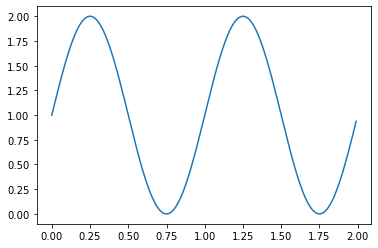
This quick & simple plot may be useful for checking your data, but it’s nearly useless for communication.

There are many possible figure components you should consider when making your figure.
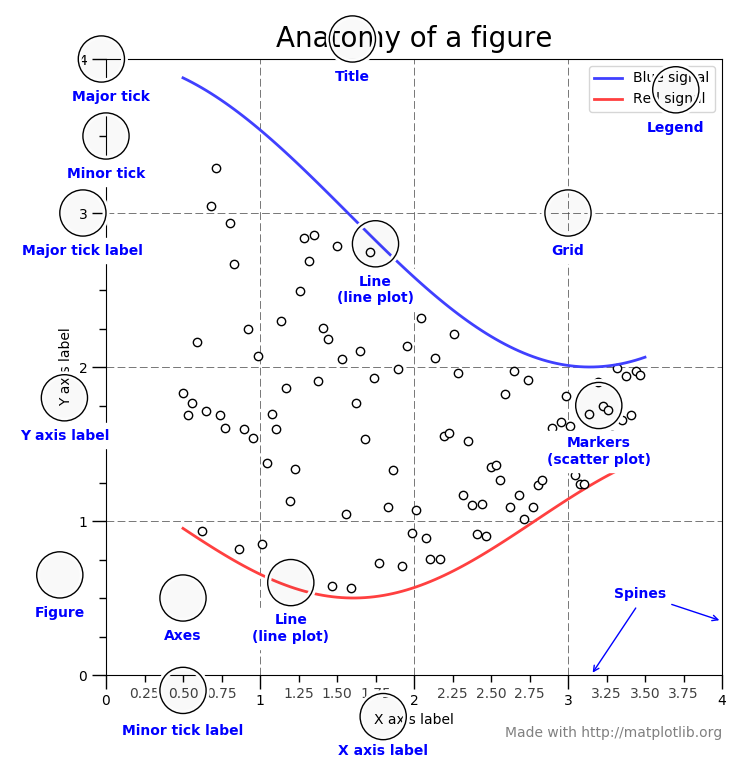
Source: Matplotlib Tutorial
For example we should add labels to our simple figure. This can be done with ax.set() or plt.xlabel. We’ll also add a grid with ax.grid().
import matplotlib
import matplotlib.pyplot as plt
import numpy as np
# Data for plotting, a simple sine wave
t = np.arange(0.0, 2.0, 0.01)
s = 1 + np.sin(2 * np.pi * t)
fig, ax = plt.subplots()
ax.plot(t, s)
ax.set(xlabel='t', ylabel='s', title='Bare Necessities Plot')
ax.grid()
fig.savefig("test.png")
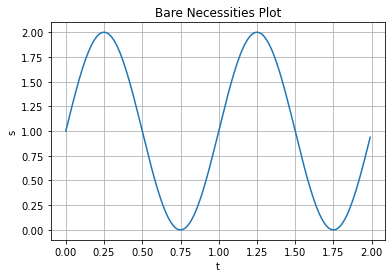
There, we have done the bare minimium to have a readable figure. It can be saved with fig.savefig(). But we should continue and learn more tools for making good, publication quality figures.
Using Additional Plot Features¶
There are many strategies for making good scientific figures. The primary goal is clarity, rather than aesthetics, but bad plots are also often ugly. The first thing to consider are your axes: they should be clearly labeled with a descriptive label that includes units. Increasing the fontsize of the labels makes them easier to read also.
# We can use the same data again, we don't need to import matplotlib or declare t and s again
fig, ax = plt.subplots()
ax.plot(t, s)
ax.set_title('Simple Plot', fontsize=20)
ax.set_xlabel('Time (s)', fontsize=16)
ax.set_ylabel('Wave Height (m)', fontsize=16)
plt.xticks(fontsize=12)
plt.yticks(fontsize=12)
ax.grid()
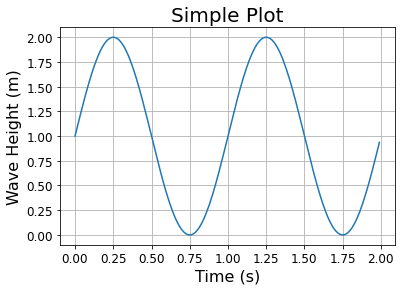
If you are plotting more than one dataset together on the same axes you should make it clear to the reader what the two datasets are with a legend using plt.lengend(). You can also differentiate them but plotting with different line or marker types. You may also want to adjust the limits of the x or y axis, this can be done with plt.xlim([xmin, xmax]) and plt.ylim([ymin, ymax]) or ax.set(xlim=(xmin, xmax), ylim=(ymin, ymax)).
# declare a second variable to plot
s2 = 1 + np.sin( np.pi * t)
# We can use the same data again, we don't need to import matplotlib or declare t and s again
fig, ax = plt.subplots()
ax.plot(t, s,'-',label='Day 1') #make the second line solid
ax.plot(t, s2,'--',label='Day 2') #make the second line dashed
ax.set_title('Simple Plot', fontsize=20)
ax.set_xlabel('Time (s)', fontsize=16)
ax.set_ylabel('Wave Height (m)', fontsize=16)
plt.xticks(fontsize=12)
plt.yticks(fontsize=12)
ax.set_xlim([0.0, 2.0])
ax.grid()
ax.legend()
plt.show()
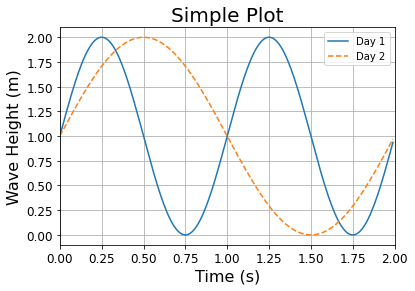
Other Types of Plots¶
matplotlib is capable of making many types of plots besides just simple line-plots. Below are examples of several, but not all, of the types of plots you can make. More compicated examples with more features can be found in the matplotlib gallary.
Histogram¶
We use histograms throughout this course to visualize how our data is distributed. They are easy to produce with the function plt.hist() (documentation). You can set the number of bins you plot. Setting density=True will make the histogram a probability density: each bin will display the bin’s raw count divided by the total number of counts and the bin width, so that the area under the histogram integrates to 1. density=False is the default, where the total count per bin is displayed.
N_points = 1000
n_bins = 20
# Generate a normal distribution, center at x=0
x = np.random.randn(N_points)
# make a figure object with axis
fig, ax = plt.subplots()
# We can set the number of bins of the histogram with the `bins` kwarg
ax.hist(x, bins=n_bins,density=False)
ax.set_xlabel('x-axis', fontsize=15)
ax.set_ylabel('y-axis', fontsize=15)
ax.set_title('Example Histogram', fontsize=18)
plt.show()
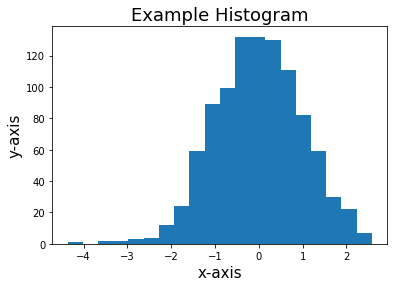
Bar Plot¶
Bar plots are similar to histograms, but the bins of counts are some category (like fruit in the example below). plt.bar() takes lists of names and count values as input.
data = {'apple': 10, 'orange': 15, 'lemon': 5, 'lime': 20}
names = list(data.keys())
values = list(data.values())
fig, ax = plt.subplots()
ax.bar(names, values)
ax.set_xlabel('Fruit', fontsize=15)
ax.set_ylabel('Count', fontsize=15)
ax.set_title('Example Bar Plot', fontsize=18)
plt.show()
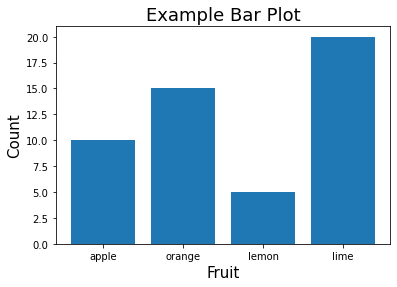
Scatter Plot¶
For some datasets plotting as marker points instead of a line will be prefered. The plt.scatter() function has nice features that allow you to set the size and color of the markers. Their color and size can be set for aesthetic reasons or set by other variables (besides x and y values) to communicate more information by setting the c= and s= arguments. The markers can be set as transparent with the alpha= argument.
N_points = 100
# Generate a random normal distributions, for x and y variables and also some for color and marker volume
x = np.random.randn(N_points)
y = np.random.randn(N_points)
scatter_color=np.random.randn(N_points)
scatter_size=np.random.randn(N_points)*500
fig, ax = plt.subplots()
ax.scatter(x, y, c=scatter_color, s=scatter_size, alpha=0.5)
ax.set_xlabel('x-axis', fontsize=15)
ax.set_ylabel('y-axis', fontsize=15)
ax.set_title('Example Scatter Plot', fontsize=18)
ax.grid(True)
plt.show()
/opt/anaconda3/lib/python3.7/site-packages/matplotlib/collections.py:885: RuntimeWarning: invalid value encountered in sqrt scale = np.sqrt(self._sizes) * dpi / 72.0 * self._factor
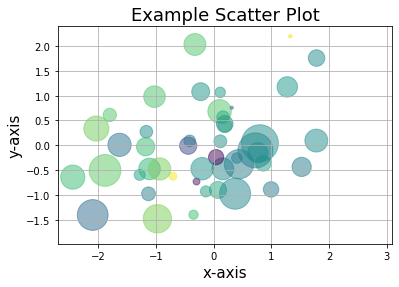
Contour and Contourf¶
Contour plots (line or filled) are a method of plotting a 3D surface in 2D by plotting constant z values (contours) on a (x,y) grid. Lines are drawn connecting (x,y) coordinates with the same z value. We’ll use contour and contourf for mapping.
contour¶
plt.contour plots contour lines. It takes three variables: an x-grid and y-grid, and the z value (think of it as the height of the surface).
delta = 0.025
x = np.arange(-3.0, 3.0, delta)
y = np.arange(-2.0, 2.0, delta)
X, Y = np.meshgrid(x, y)
Z1 = np.exp(-X**2 - Y**2)
Z2 = np.exp(-(X - 1)**2 - (Y - 1)**2)
Z = (Z1 - Z2) * 2
fig, ax = plt.subplots()
CS = ax.contour(X, Y, Z)
ax.clabel(CS, inline=True, fontsize=10)
ax.set_title('Simplest default with labels')
plt.show()
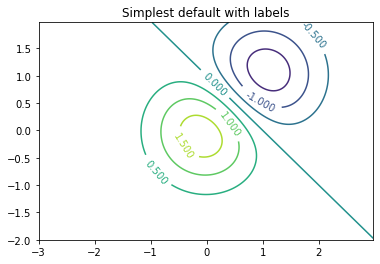
contourf¶
plt.contourf draws filled contours. Like plt.contour it takes three gridded inputs and x, y, and z. You can set the number of contour levels with the levels agrument e.g. levels=40.
delta = 0.025
x = np.arange(-3.0, 3.0, delta)
y = np.arange(-2.0, 2.0, delta)
X, Y = np.meshgrid(x, y)
Z1 = np.exp(-X**2 - Y**2)
Z2 = np.exp(-(X - 1)**2 - (Y - 1)**2)
Z = (Z1 - Z2) * 2
fig, ax = plt.subplots()
CS = ax.contourf(X, Y, Z, levels=12)
# Make a colorbar for the ContourSet returned by the contourf call.
cbar = fig.colorbar(CS)
cbar.ax.set_ylabel('Colorbar label')
ax.set_title('Simplest default with labels')
plt.show()
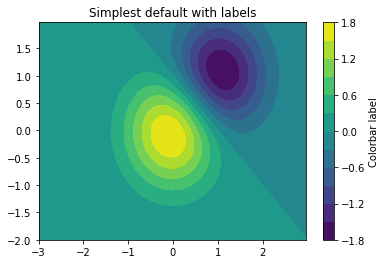
Representing Uncertainty/Error¶
Observations always have an associated uncertainty. Communicating these uncertainties is an important task for scientists.
Errorbars¶
The errorbars respresent the scatter in the data. plt.errorbar can be used to add vertical or horizontal errorbars with the arguments yerr or xerr respectively. These arguments should be set with an array the same length as the x and y arrays you are plotting and contain the corresponding error values.
# example data
x = np.arange(0.1, 4, 0.5)
y = np.exp(-x)
# example error bar values that vary with x-position
error = 0.1 + 0.2 * x
fig, ax = plt.subplots()
ax.errorbar(x, y, yerr=error, fmt='-o')
ax.set_title('Example Line Plot with Errorbars', fontsize=18)
ax.set_xlabel('x-axis', fontsize=15)
ax.set_ylabel('y-axis', fontsize=15)
ax.grid(True)
plt.show()
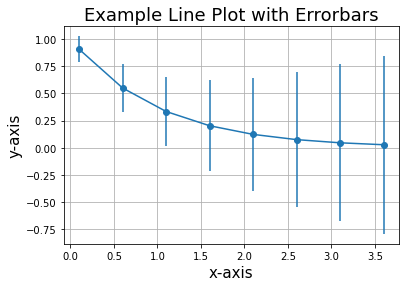
Box and whisker¶
Box plots also communicate the distribution of the data represented by the marker, but they give more information (median, maxiumum, minimum, quartiles). The box gives the bounds of the lower and upper quartiles (25%-75%) of the data. The whiskers extend to the minimum and maximum values, excluding outliers (plotted as points). The line through the box is the sample median.
# Random test data
all_data = [np.random.normal(0, std, size=100) for std in range(1, 4)]
labels = ['x1', 'x2', 'x3']
fig, ax = plt.subplots()
# rectangular box plot
bplot1 = ax.boxplot(all_data,
vert=True, # vertical box alignment
patch_artist=True, # fill with color
labels=labels) # will be used to label x-ticks
ax.grid(True)
ax.set_title('Rectangular box plot', fontsize=18)
ax.set_xlabel('Three separate samples', fontsize=15)
ax.set_ylabel('Observed values', fontsize=15)
plt.show()
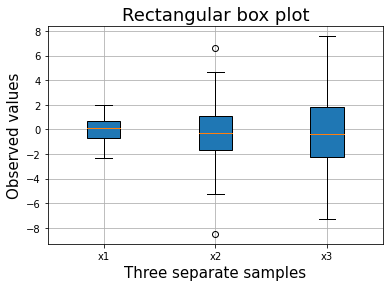
Violin¶
Violin plots are similar to box plots, but display even more information. Rather than summary statistics (e.g. median, quartiles) they show the full distribution of data.
# generate some random test data zero mean
all_data = [np.random.normal(0, std, 100) for std in range(6, 10)]
fig, ax = plt.subplots()
# plot violin plot
ax.violinplot(all_data,
showmeans=False,
showmedians=True)
ax.set_title('Example Violin plot', fontsize=18)
ax.set_xlabel('x-axis', fontsize=15)
ax.set_ylabel('y-axis', fontsize=15)
ax.grid(True)
plt.show()


